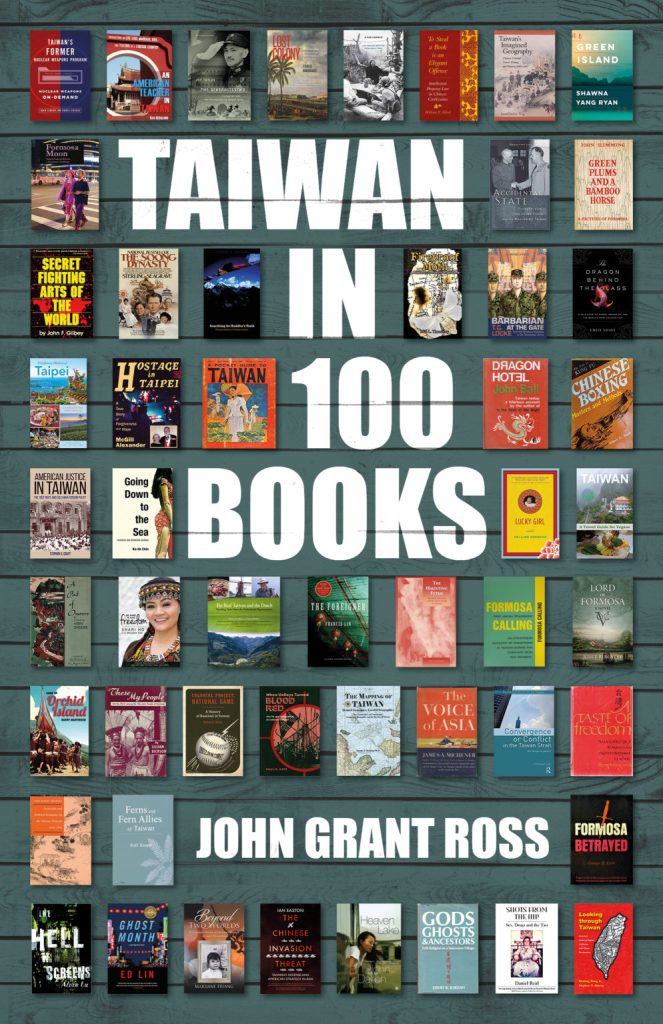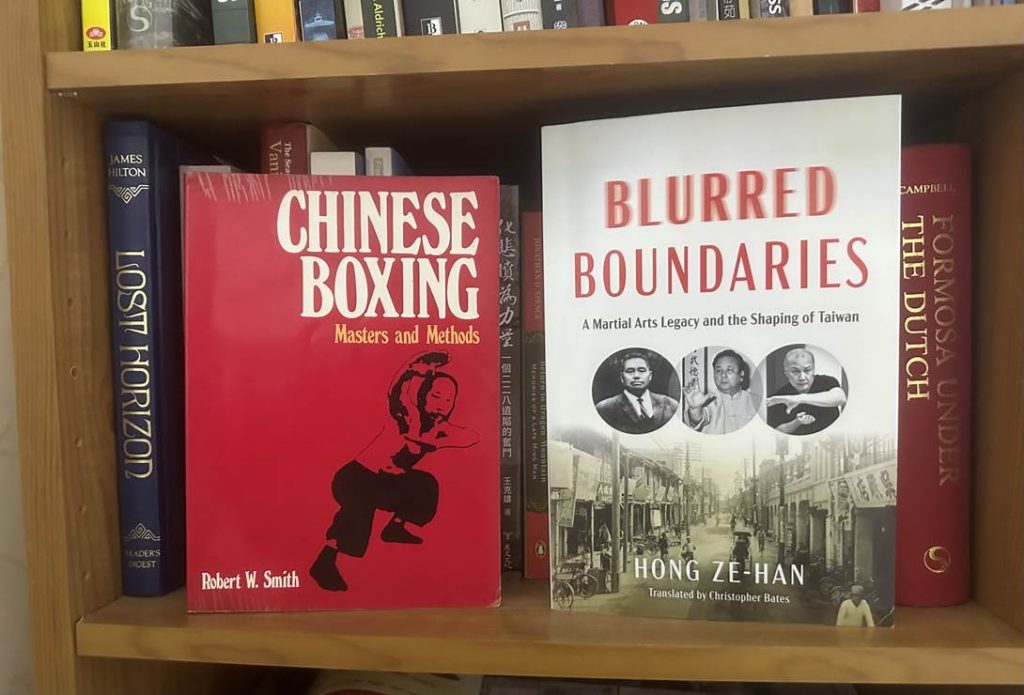Today, the Kaohsiung Times gratefully begins running John Ross’ Taiwan in 100 Books (2020). It tells the story of Taiwan through the prism of some of the most important and/or most interesting English-language works on the country. Unfortunately, due to some dark publisher drama, the title is not currently available for sale; so, John is making it available here. In the coming months, we will, in weekly installments, be serializing the entire book.

Part one of CHAPTER ONE – MYSTERIOUS TAIWAN
Taipei in 1957. A poor, bustling city of shopkeepers and soldiers, the once orderly Japanese colonial city now a sprawling settlement accommodating the tsunami of Chinese refugees who had fled to the island after the Communist victory in China. The exodus had brought to Taiwan the wheat and the chaff: the artists and academics, engineers, master chefs, gangsters, warlords, whores, battle-hardened officers and more often press-ganged village boys. In the shacks that sprang up, in the appropriated Japanese-style houses, in the military villages could be heard the tongues from every corner of China. The exiles carried with them the smoldering embers of Chinese culture in all its diversity – its literature, religions, languages and dialects, cuisines, and martial arts.
And into this concentration of culture came American millionaire John F. Gilbey, a world-renowned martial arts expert and practitioner. He had been to Taiwan in 1955 and seen gifted fighters of every description, some capable of amazing feats; “men who could lightly touch your body and bring a bright red blood line immediately to the surface,” and others who “could support over a two-hundred-pound weight attached to their genitalia.”
However, one art eluded Gilbey. He had heard for years of “the delayed death touch.” Intrigued yet doubtful that it existed, he would see it firsthand on his 1957 trip to Taiwan, and describe this experience in his bestselling Secret Fighting Arts of the World (1963), which he wrote at the insistence of Tuttle, Japan’s leading English-language publisher.
Gilbey was conversing (in Mandarin) with a renowned Shaolin teacher in Taipei named Oh Hsinyang, when the topic turned to the correlation between vulnerable body points and the time of day. Oh explained “that Shaolin masters for centuries had been guided in their atemi (strike) by the time of day.” The theory was that blood came close to the surface at different times of the day. “A boxer had only to be aware of the course of this circulation and to attack the appropriate part at the time the blood was near the surface. Injury was certain and death probable then.” But did it really work? Gilbey asked for proof. Oh obliged, demonstrating a light but rapid touch on a student, who immediately collapsed into an incapacitated heap. No need to worry, Oh assured, as fellow students administered some medicine to revive the student.
Before taking his leave, Gilbey raised the topic of the delayed death touch, asking if it was a variation on what he had seen. Could the impact be delayed? Had Oh heard of it? The Shaolin master remained silent for a moment. A few words to his students and all except a teenage boy vacated the dojo room. Yes, he said, the time strike and delayed death touch were indeed related, though the ability to perform such a feat was beyond all but the very best masters. In Taiwan he alone possessed the skill and he almost never performed it because of the obvious danger, and there were, of course, not many volunteers stepping forward to have it demonstrated on them.
Oh asked Gilbey if he would be willing to submit. The American stammered out a series of excuses. Oh summoned the boy who had remained behind; his son had never experienced it and, his father said, was badly in need of the education. With his right index finger, Oh touched a point just below the boy’s navel. Turning to Gilbey, Oh explained:
“That is all, just a touch, the ch’i transmitted very smoothly. Since you leave in a week I have timed the effect of this touch for three days hence. About noon on that day Ah-lin will begin to vomit and must go to bed. So that your Western cohorts will not accuse me of chicanery I make you a present of Ah-lin until that time. I shall meet you in Taipei three days hence at the Union Hotel. Until then, farewell.”
Gilbey spent the next three days with the boy, who helped him with various chores and errands. When Mr. Oh came to the hotel on the morning of the third day, Gilbey confirmed that Ah-lin had not left his sight, and reported that the boy was in good health. The three of them took a walk around “the disordered, squalid downtown area of the city” then returned to the hotel room. A short time later, the boy suddenly lost consciousness. Gilbey could hardly feel a pulse, and Ah-lin appeared dazed and pale. The father administered medicine and massage treatment. Ah-lin revived but was still weak. From the father there was no hint of triumphant pride or theatrical showmanship, but instead a somberness as if regretting the display and now feeling irked that he had been pushed into proving his martial arts prowess. Oh said it would take three months for the boy to recover, but that there would be no lasting aftereffects. And there was no lasting ill will – when Gilbey departed Taiwan a few days later, Oh Hsin-yang and his son were at the port to see him off.
“The Delayed Death Touch” was the first chapter of Gilbey’s Secret Fighting Arts of the World,and perhaps the most memorable, though there was plenty of competition. Other chapter titles included “The Ganges Groin Gouge,” “The Macedonian Buttock,” and “The Parisian Halitotic Attack.” Yes, if the insane content was not enough, the very chapter titles themselves should have alerted readers to the fact the book was a hoax.
The man behind the deception was Robert W. Smith (1926–2011), a real-life Gilbey of sorts: as a teenager he had begun his martial arts odyssey with Western boxing and wrestling, and then moved onto judo, and finally in his mid-thirties, while stationed in Taiwan (1959–1962) as an intelligence officer for the CIA, found his home in the Chinese martial arts training under celebrated masters. On his return to the United States, writing about and teaching what he had learned, he was an important pioneer responsible for bringing East Asian martial arts to the West.
“Gilbey was a joke, an exaggeration, a fantasy,” Smith says in his 1999 memoir, Martial Musings: A Portrayal of Martial Arts in the 20th Century. “We were sure that readers would be smart enough to realize this. We were wrong.” When Smith wrote “we,” he was referring to the hoax being a joint inspiration: “John Gilbey was born in Donn Draeger’s house in Tokyo in 1961.” Draeger was a World War II and Korean War Marine vet who became an influential practitioner of martial arts. Among his many books, the most important was Asian Fighting Arts (1969), which he co-authored with Smith. To the general public, Draeger was best known as the martial arts coordinator (and actor Sean Connery’s stunt double) for the 1967 James Bond film You Only Live Twice.

Cover of Marital Musing showing Robert Smith in later years; from publisher Via Media

Fair use, https://en.wikipedia.org/w/index.php?curid=4762156
Caption: Draeger on the set of the James Bond film You Only Live Twice (1967)
Smith and Draeger’s wild inventions were aimed at lampooning the oft-told legendary feats of superhuman fighters. You have to admire the publisher for being willing to go along with the joke. Charles E. Tuttle Co. (now called Tuttle Publishing) was a respectable publisher, established by American Charles E. Tuttle in 1948. After working on General MacArthur’s staff during the post-war reconstruction of Japan, Tuttle, who was from a publishing family, stayed on and set up his company. Among the wide range of titles published by Tuttle were numerous books on martial arts, especially on Japanese forms; these books would play a significant role in introducing East Asian martial arts to the West.
Smith wrote a sequel to his bestselling hoax,called The Way of a Warrior, which contained even more outrageous tall tales – though there were some straight stories thrown in; part of the fun is in trying to distinguish them, though you don’t need to speculate too long to decide which category held Mama Su’s deadly art of spitting betel nuts, and Fotan, an Icelandic martial art drawing on energy from black holes. A third Gilbey book, Western Boxing and World Wrestling (1986), was almost entirely factual. Unlike the earlier titles, it didn’t sell well and was seldom quoted.
Robert W. Smith’s greatest written contribution was his Chinese Boxing: Masters and Methods (1974). Covering his time in Taiwan training with martial arts masters, it’s a magnificent book; the rich variety of fighting forms then concentrated on the island was exceptional. As Smith wrote, “No national form of fighting approaches Chinese boxing in the diversity and profundity of its forms.”
In Chinese Boxing, Smith wanted, on top of educating readers about Chinese fighting arts, to offset the sensational way kung fu was portrayed in the media, especially in films. Notice the use of “boxing” in the title rather than the more exotic “kung fu.” Although Chinese Boxing is seemingly matter-of-fact – Smith relays fantastic tales and then dismisses them – this remains the book of a romantic who was a firm believer in that magical life force called qi.
Smith was based in Taipei, a city he describes as having been built for 250,000 but accommodating six times that population. He counted himself lucky to have a house on “beautiful Yang Ming Mountain,” a short distance to the north. Smith met and trained with an incredible array of masters, packing more into his three-year stay in Taiwan than most expats manage in a decade or two. It was the kind of immersive exploration we like to imagine ourselves doing but don’t get around to. Studying with several teachers concurrently, with hours of practice every day and then hours digesting it all, was mentally and physically grueling: exhaustion and pain were constant companions. Smith’s perseverance was admirable, yet it also reveals a certain selfishness; he was a married father at the time, so his deep dive into martial arts in Taiwan meant ignoring the family.
Among the masters Smith describes was Liao Wu-ch’ang, known as “the Monkey Boxer” because of his low, crouching style. Nimble and energetic despite his advanced years and four wives, Liao credited his impressive health to getting up at three in the morning for a daily cold bath (which consisted of simply pouring a basin of cold water over himself). Liao was a traditional Chinese medicine doctor and taught Smith about “the esoteric art of attacking vital points,” as well as introducing him to a native Taiwanese boxer, Ch’en Ching-chang, near Keelung, who possessed “one-finger skill.” Ch’en gave a minor demonstration hinting at his power but would not show the one-finger fighting application, having sworn not to use it since killing a man with it fifteen years previously.
Chinese Boxing includes fascinating sections on elite masters Wang Shujin and Hung I-Hsiang; both men were devastating fighters, famed practitioners of the internal martial arts of xingyi (hsing-i) and bagua, which rely on the subtle channeling of qi rather than brute physical force.

Hung I-Hsiang (left): https://en.wikipedia.org/w/index.php?curid=9025610
It was the third main internal art, tai chi (taiji), however, that captivated Smith. And the man who won him over to this was Cheng Man-ch’ing – known as the “Master of the Five Excellences” for his skill in painting, calligraphy, poetry, medicine, and tai chi. Smith describes Cheng’s teaching as “the most profound” he encountered and writes of the man with reverence, in many ways taking on the Chinese model of disciple to master. Whereas Smith would increasingly move toward the artistic and spiritual aspects of martial arts – asking what tai chi could do for character – his old friend Draeger disagreed about Cheng’s approach, favoring a more scientific focus on effective violence.

Cheng Man-ch’ing: https://commons.wikimedia.org/w/index.php?curid=72731889
Shortly after moving to Washington, D.C., in 1962, Smith began teaching tai chi to a Saturday-morning YMCA class, which was to continue for twenty-seven years. In 1964, Cheng Man-ch’ing moved with his family to New York, where he taught tai chi. Cheng and Smith collaborated on a book T’ai Chi, the Supreme Ultimate Exercise for Health, Sport, and Self-defense (1967).
***
As audacious and successful a hoax as Smith’s Secret Fighting Arts of the World was, it pales in comparison to a 1704 work on Taiwan called An Historical and Geographical Description of Formosa, an Island Subject to the Emperor of Japan. The book, one of the most outrageous literary hoaxes ever perpetrated, was authored by a young Frenchman calling himself George Psalmanazar.
[END OF BOOK EXTRACT]
On that bombshell, we’ll finish for today. We’ll tell the story of hoaxer extraordinaire Psalmanazar next week.

Caption: John’s bookshelf with Robert W. Smith’s Chinese Boxing: Masters and Methods (1974), with a picture of the “Monkey Boxer.”. On the right is Blurred Boundaries, a biography of perhaps Taiwan’s greatest ever martial artist, Hong Yixiang 洪懿祥, written by his son, Hong Ze-han, and translated into English by martial artist and author Chris Bates. John Ross spoke with Chris about the book on the Bookish Asia podcast: https://open.spotify.com/episode/7MFJCWxBF6ez5dQGVaPMae
He also spoke with Chris about his martial arts experiences in Taiwan in a Formosa Files episode: https://www.formosafiles.com/bonus-episode-way-of-the-warrior-martial-arts-master-chris-bates/
Buy Audiobook HERE




1 Comment
Great book, highly recommend it